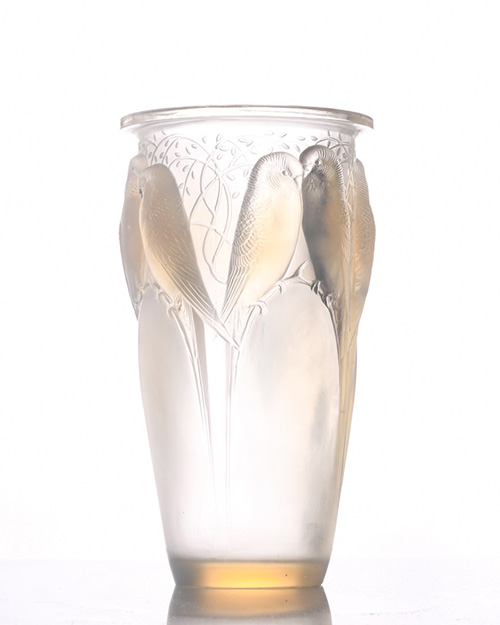Rene Lalique was one of the most successful glass makers of all time, making some of the most extraordinary pieces of glassware from 1905 up until his death in 1945. His son, Marc, was his successor, taking charge of the family business and working until his own death in 1977, when it was then passed on to his own daughter.
Identifying an authentic Lalique is surprisingly straightforward once you know what to look for. Lalique incorporate many small details into their designs that are often missed by counterfeit manufacturers, and understanding these details and the business' historical timeline is key to separating a real from a fake.
Pieces made within the period of 1905 to 1945, are worth considerably more than the ‘modern’ pieces that came after Rene Lalique’s death. Therefore, establishing an accurate date in respect of your Lalique is crucial to realising its value.

SIGNATURES AND TRADEMARKS
Every piece of Lalique glassware is signed with the company trademark. This signature is the most obvious indicator of authenticity. Pieces made before 1945 were signed with an ‘R’ in front of the signature, to signify that they were made by Rene Lalique himself and as such are worth more.
However, after his father’s death, Marc Lalique removed the ‘R’ from in front of the signature, and in 1978, a new trademark was established altogether. The registered trademark became an ‘R’ within a circle, that sits alongside the Lalique signature. This signifies that a piece is modern.
Counterfeit manufacturers often try to forge the original ‘R’ onto pieces that are either post-1945 or fake entirely, in order to increase its value. A false signature is usually easy to spot as they are typically bold, cursive, and located in very obvious places on the item. However, a genuine Lalique will always have very small and modest signatures that are placed in subtle locations such as within the design or under the base.
STATED PLACE OF MANUFACTURE
Another common mistake seen on counterfeit Laliques, is that they have ‘made in France’ or ‘made in Paris’ etched onto them. Lalique likes to keep things on the simpler side, instead signing their pieces with ‘Lalique, France’.
FORMATION OF THE GLASS
The formation of the glass is also a highly distinguishable feature of Lalique glassware. After 1945, the lead oxide content in the crystal was doubled, from 12% to 24%, making them incredibly heavy pieces of decorative art. If you were to directly compare a genuine Lalique to a counterfeit, you would easily notice the difference in weight, as well as see that the transparency of the genuine is far clearer than that of the fake, as a result of the lead oxide content.
Whilst the increased lead oxide quantity can be seen with the naked eye alone, it can also be properly tested using a long wave black light. Under the light, colourless pieces pre-1945 appear yellow, and post-1945 colourless pieces appear blue. If these distinctions aren’t noticeable, then you could be dealing with a fake.
COLOUR
Lalique glassware is only available in either colourless glass, or the colours red, green, amber, and blue. Red is the most sought-after, purely because it is the most difficult colour to achieve, which is why it is one of the more common colours in Lalique counterfeits. If your Lalique happens to be a rare colour, it is doubly important you check its authenticity to make sure it is definitely what it claims to be.
SEAMLESS FINISH
Lastly, one of Lalique’s defining qualities is its sleek and seamless finish. As with any expensive glassware, an authentic Lalique is crafted with such skill that there should be no signs of manufacturing faults or imperfections in the glass. The presence of a seam suggests the glass has been moulded and therefore not a Lalique, so be sure to look out for this.
As with any item of value, it is always important that you purchase from a reputable source, and that you carry out research prior to purchase. At Dawsons, our team of specialists have years of experience in their respective fields and are always happy to help clients comfirm the authenticity of their items.
CREDITS: https://www.dawsonsauctions.co.uk/news-item/how-do-i-know-if-my-lalique-is-real/?pc=15


